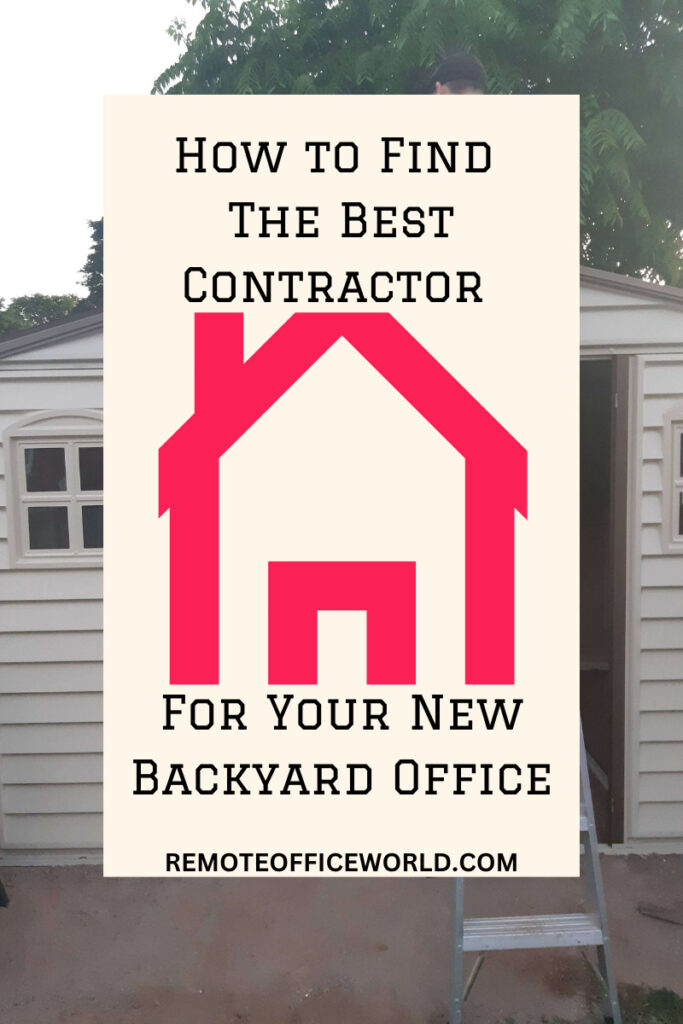
It’s hard to put a genie back into the bottle once it’s released.
That’s where many of us found ourselves after covid — our employers were asking us to put the genie back by returning to work full time from the office.
After a taste of the freedom and flexibility of working from home, that was a tough pill to swallow.
I know I didn’t like the idea.
It was the inspiration to build the RemoteOfficeWorld.com website.
I wanted to work in my backyard on summer days and in my garage office in the winter. I didn’t want to return to the office full time for the next 20 or 30 years.
Building my own backyard business where I would be my own boss and set my own schedule seemed like a no brainer.
It had to happen!
There have been ups and downs along the way. I’ve learned a lot about launching a profitable backyard business.
I want to share those lessons with you so that your transition to the work from home lifestyle is a little less painful.
Below are 10 steps to launch your profitable backyard business (I followed some more closely than others) that can help you avoid common hiccups that cause home businesses to fail.
Step 1: Find A Profitable Business Niche
You might have a ton of experience, but that won’t always translate into great business opportunities.
Perhaps, you’re great at knitting hats. That’s great, but there’s probably not a huge market for that (apologies to all the knitting enthusiasts out there!)
Now that workshop in your shed where you wow your family with your woodworking skills might be a different story.
You could easily turn that into a profitable backyard enterprise making cornhole games and selling them online.
Yes I love playing cornhole in the summer — I could be a customer!
The point is you need to choose a home business niche you’ll enjoy and one that’s in demand.
Answering the following 3 questions will help you choose a niche that has good potential:
- Is there an existing demand for the product or service you plan to offer?
- Can you grow the business long term or is it a short term fad?
- Do you have the expertise and passion to build a business in your chosen niche?
Step 2: Research Your Market

Now that the brainstorming’s out of the way and you think that your profitable backyard business idea is one you’ll enjoy building with the potential to make money now what?
Hint: it's not quite time to book that luxury cruise from your potential future earnings just yet!
It’s time to take a deep dive into the market for your product or service.
Your gut may be telling you that you’ve found the ideal backyard business, but you’re going to be investing a ton of time and resources into this.
You’ll want more proof of profit potential than just a hunch and the encouraging words of support from grandma!
That makes sense right?
You have to put in the time and get your market research right.
Here’s how to do that.
5 key Tasks When Researching Your Market
Researching any market takes time, but it’s easier if you break it down by task.
Any stay at home mum or dad will tell you how hard it is to do 10 things at once! Kudos to all those that do it day in and day out!
Here’s how to tackle market research for your profitable backyard business one step at a time.
Start With Broad Research of Your Market
The internet is awash with statistics and information on every business you can imagine. Dig deep and find everything you can on the trends in your niche.
Is the market growing? What are the trends? What are the opportunities and challenges ahead of you?
Pro tip: Look for reliable sources. Don’t quit your day job and spend your life savings on an idea you got from social media.
Bob on Twitter might be right in his assessment of the earning potential of your niche, but do your own thorough research before you get started!
You may find there are some major barriers to entry in your way such as strict regulations, the need for investment in technology or just a lot of competition.
Researching a market may not be fun, but it’s a must.
I recommend doing a SWOT Analysis at the beginning, which stands for:
- Strengths
- Weaknesses
- Opportunities
- Threats
This will give you a great overview of what you’re getting yourself into. After that, it’s time to take a closer look at your competitors.
Analyze Your Potential Competitors
Even if you’re a genius inventor with a revolutionary idea, you will still have competitors.
When Edison launched his light bulb he wasn’t the only one looking into the technology. He was just the one that was able to market a stable product faster, he knew who his competitors were and how to beat them to market.
Be like Edison.
Again it’s all about asking the right questions. Who are your direct competitors? What about indirect competitors?
Perhaps there aren’t too many people making homemade cornhole games in your area. That’s great, but anyone can easily order online. Why would they choose you over the generic games they can buy from your internet competitors?
What are their strengths and weaknesses?
Maybe you can customize designs to match anything they want — their favorite sports teams, their favorite movie or anything else they can think of to put on a cornhole game. Your competitor analysis will show you where their strengths and weaknesses are.
If you find some obvious things to exploit, that may just be your ticket to beat them at the marketing game and launch your profitable enterprise.
Research Market Trends and Demand

You might not think that trends will make a big difference for your profitable backyard business, but even if you’re making custom wooden games like cornhole from your backyard there will be trends you should pay attention to.
In the 1980’s the game of lawn darts was hugely popular. Investing in the company that made these games at first glance would have seemed like a no brainer.
The problem was the game was dangerous. There were numerous serious injuries. By the end of the decade the game was banned in the USA and Canada.
Anyone who did their research could have seen this coming. The trend towards an outright ban was in the cards.
By diving deep into trends you can find out if your idea is a flash in the pan or if it has real growth potential.
Establish Pricing and Profitability Margins
If all of the research you’ve done up to now is giving you positive signals that’s great. You may have a winning idea.
There are a couple more questions you need to look at before you start any serious planning though.
What’s a realistic price for your product or service? At that price, what are your profit margins?
If you find the price that you would have to offer would be a losing proposition, it’s time to reconsider.
Chances are though there is a viable market for your business and you can make money. What next?
Plan Your Marketing and Distribution Strategy
Congratulations!
If you’ve got this far in your market research and you’re still determined to move forward, it’s time to get down to the nitty gritty.
You’ll need a solid marketing and distribution strategy if you’re going to be able to grow your business.
Consider these three important tools for your marketing:
- Develop a buyer persona to better understand your potential customers
- Choose the right marketing channels to spread the word (Social media, paid ads etc.)
- Build your brand (This is more than just a logo — it’s the business image you want to portray as a whole)
With your marketing strategy fully developed it’s now time to turn your attention towards your distribution plan. You may have a great product and know how to market it, but that won’t help if you can’t get your product to your customers.
There are a number of different methods you can use. Here are a few options to consider:
- Direct online sales — For this method you would develop your own website or e-commerce platform and sell directly to customers using a courier company such as UPS, Fedex or any other similar platform. This gives you a ton of control, but it’s also extra work for you.
- Marketplace Selling — This is a popular choice for many home businesses. In this case, you join a market platform such as Amazon or eBay and sell your products through them. It’s less complicated for you, but you will have to share some of your revenue with them for the privilege.
- Sell Through Social Media — One of the most popular methods for selling home made products or services is through social media channels. You don’t need a website and you don’t have to jump through the hoops required to join an online marketplace. However, it’s called social media for a reason. If you’re going to have success selling on these platforms you will need to engage with your audience and provide them with quality content.
- Partner With Local Business — Do you make an amazing hot sauce or a similar type of product? You may want to consider approaching restaurants or locally owned grocery stores. If you can convince them to carry your sauce it can be a great boost for your sales and an opportunity to spread the word!
Step 3: Develop A Sound Business Plan For Your Profitable Backyard Business

If you’re still sold on your backyard business idea after finishing your market research that’s great, but there’s a long way to go yet.
You have a great business idea, you’ve researched the market and you know there’s money to be made. That doesn’t mean you should jump right in.
You still need a business plan.
It helps you identify any financing you may need and any barriers to entry that may be in your way.
The last thing you want to do is invest a ton of your time into a project only to find out you can’t afford the tools you need to run it.
Your business plan is also where you’ll set your goals. Where do you want to be in a year? What about 5 years?
You’ll want to create a clear mission for your business. This will act as a map to help keep you on track.
Another big reason for having a great business plan is for investors. Even if you’re just looking to secure a small loan to launch a backyard business, this document is a great way to show potential investors that you’re a good bet.
Remember, your plan will need to change and evolve over time as your business evolves. Plan on reviewing it at least once per year.
Step 4: Learn and Follow All Legal Requirements

Learning about the legal requirements and rules you’ll have to follow launching a profitable backyard business isn’t anyone’s idea of fun. Okay, maybe there are a few exceptions to this rule, but not many.
For most of us, the last thing we want to do is look up a bunch of boring laws, by-laws and regulations that might affect how we approach building our home business.
It’s just part of the process.
If you want to build a sustainable full time business from the comfort of your backyard you have to follow the rules.
Here are 5 legal issues you may need to consider for your new home business:
- Registering Your Business
- Obtaining a business license
- Zoning regulations
- Building permits
- Tax payments
Depending on the nature of your business these may or may not apply to you. You’ll want to do your homework to find out if any of them do before you’re too far along in the process.
Step 5: Setup A Professional Backyard Office Space

One of the hardest things about working from home during Covid was trying to find a quiet space to work. First I tried the bedroom, but there was too much background noise.
From there I decided to set up a workspace in my garage. That was okay in the winter, but it was a little stuffy in the summer.
That’s why I finally settled on converting my shed into an office. I still work from home, but now I have a quiet space, separate from the family noise where I can be productive.
If you like the idea of setting up a professional backyard office space, but you’re not exactly a master in the DIY building world check out our Backyard office contractors directory to find some professional help near you.
The bottom line is this.
You need a great space to work if you want your profitable backyard business to become a reality. Whether that means an office shed, garage workshop, heated greenhouse or something else.
There’s no point trying to start a home business if you don’t have a great work setup.
Step 6: Create A Brand and Develop A Marketing Strategy

It’s not just big businesses that have recognizable brands any more.
The social media world is littered with individuals that have branded themselves successfully. People like Jake Paul, PewDiePie and MrBeast make insane amounts of money using their personal brand on Youtube, TikTok and Twitter.
You’ll probably never have the influence of these individuals, but that doesn’t mean you shouldn’t make the effort to build your own successful brand.
Let’s take a look at how to do it.
Differentiate Your Home Businesses Brand
Your backyard business won’t go anywhere if you don’t establish a consistent and strong brand across every online platform you’re targeting as well as using traditional real world ones.
If you don’t know what the term unique value proposition means, you’ll want to learn fast. Essentially, it’s what makes your brand different and valuable. Why your market should choose you over your competitors.
That’s just the start.
Remember that market research you conducted earlier? That comes into play here as well.
Develop Brand Credibility and Trust
Using what you’ve learned, you can now develop a strategy to address your target audience. It’s time to create a compelling message that will speak to them and convince them that you have the answers or products they’re looking for.
Creating a buyer persona is another good idea at this point. It helps you better understand your customers so you can make sure you’re using the right channels to reach them. There are a number of tools available on line that can help you with this. Here are 3 of the best:
Target The Right Channels With Your Marketing Strategy
There’s no use spending time creating a TikTok channel if you’re targeting seniors that will never watch your 30 second masterpieces.
You can’t build a relationship with your potential customers if they don’t know where to find you or what it is you’re selling.
Make sure you’re always:
- Using the right marketing channels for your audience
- Working with a realistic and sustainable marketing budget
- Networking both online and offline
- Consistent in your branding and your message
Be Ready to Expand As Your Profitable Backyard Business Grows
If you’ve done everything right, you’ve developed a strong brand and you’ve picked a great niche for your backyard business, growth will happen.
An essential part of your marketing strategy is having a plan for growth. Are you happy with remaining a home based business or are you prepared to expand as your popularity grows?
It’s okay to stay small if that’s what you want, but it’s something you should think about early on. If you are interested in expanding beyond your home business base, think about what that might look like and how you would prepare for it.
Step 7: Build An Online Presence For Your Home Business

There are few (if any) home business ventures that won’t benefit from a strong online presence. Even outdoor contractors building sheds and gazebos in rural Texas have a website and multiple social media accounts.
You can’t compete on the same level as your competitors if you don’t have a similar or greater web profile.
The process never ends.
I’m updating my website and social media accounts with new content and new media every single week. If you’re not sure where to start, here are 9 steps you can use to create and build your online presence:
- Create a WordPress website: There are lots of different Content Management Systems (CMS’s) you can use to build a website, but WordPress is by far the best. It’s used by 63.2% of all websites today that use CMS’s for good reason — it’s versatile and easy to use.
- Optimize Your Website for SEO: Having a website is a great starting point, but it’s not much good to you if no one can find you. If you want to be found on Google your site needs to be optimized for search. This involves both keyword research and technical SEO. If you’re not sure where to start, Search Engine Land has a ton of great resources.
- Build Through Content Marketing: Now that you have a great website fully optimized for SEO, it’s time to add content. You’ll want to build helpful content that answers the questions your target audience might ask. This helps to establish you as an expert in your industry and develops trust in your brand.
- Develop A Social Media Audience: It’s hard to be in business these days and not be on social media. 72% of business executives use social media when making decisions for their company. You need to pay close attention to your social media if you don’t want to get left behind.
- Build Relationships With Email Marketing: As your website grows in popularity you’ll want to develop a plan to engage with your visitors and encourage them to become customers in the future. Email marketing is one of the best ways to do that. Now that you know they trust you, you can use more direct email marketing to offer exclusive promotions and incentives to convince them to buy your products or services.
- Consider Online Advertising: Depending on your business model, online advertising may or may not be a good idea. You can advertise using pay-per-click services such as Google Ads or social media advertising on one of the major platforms such as Facebook. Many backyard businesses do just fine with content marketing and engaging on social media without ever paying for an ad.
- Create A Google Business Profile: We’ve all seen Google reviews for businesses and places. How do you get great reviews so people can see what a great product you offer from all your positive testimonials? You need to create a Google Business Profile so the world can find you and leave that 5 star review!
- Build Relationships With Influencers: Every industry has influencers and developing relationships with the ones in your line of business can be a great way to grow your own business. Search your favorite social media platforms and start engaging with them. If you can find mutually beneficial ways to collaborate with them it could be a big boost for your small home business.
- Continue to Grow With Engagement: Never rest once you’ve tasted initial success. Keep on top of your online presence, continue to add helpful content and continue to engage with your audience and influencers. Remember to respond as soon as possible on your social media platforms to comments and always keep it professional.
Step 8: Create A Financial Plan and Set Pricing

Now that you’ve built the foundations for your profitable backyard business, it’s time to create a financial plan and set pricing for your products and/or services.
This is a critical step.
There are costs involved to launch any business. You have to take these into account when you’re setting your pricing.
With your market research in hand you already have a good idea of what the demand for your product or service looks like. This will help you set a price you can live with that has a decent profit margin and at a price point that your potential customers are willing to pay.
You’re going to want to revisit your pricing structure on a regular basis. Market conditions can change quickly and it’s important to react promptly if you want to stay ahead of the curve.
Step 9: Develop and Commit to A Strong Customer Service Approach

It isn’t enough just to spend your time pushing potential customers through the sales funnel towards a purchase.
Not if you want them to come back.
You have to develop a strong approach to customer service that lets them know you believe in your product and that it addresses a real pain point for them. Those 5 star reviews won’t happen unless you build real lasting relationships with your customers, visitors and clients.
Here are 5 things to keep in mind that can help you develop a great relationship with your customers:
- Seek to understand your customers needs
- Make sure your team (if you have one) uses a consistent approach with customers
- Respond to customer queries and complaints quickly
- Develop a personalized experience with each new customer
- Exceed their expectations by going that extra mile
We’re not quite done yet. There’s one more step you need to take to launch a profitable backyard business.
Step 10: Plan For Growth and Expansion

There’s always a what’s next.
That is unless you’re content with making just enough to get by. If you want to truly live comfortably and leave the 9 to 5 behind forever you’ll need a plan for growth and expansion.
If you develop a plan for growth early on in the life of your profitable backyard business you’ll be able to scale up quicker when the opportunity arises. Companies that get this step wrong can experience major setbacks.
In 2013 Target launched its first store in Canada, by April 2015 all of its stores in Canada had closed. They failed for a number of reasons, but one of the big ones was a faulty distribution network.
It’s a great feeling watching a business you started in your backyard grow, but it isn’t a lot of fun if you have to shut down a year later because you didn’t have a solid growth plan. Including a plan for growth in your business plan will help lower your risk of failure in the future.
Launch Your Profitable Backyard Business Today
Launching a backyard business is going to be hard work. There’s no way around that.
If you’re not prepared to put in long hours to make your venture a success it’s best to walk away now. For those that aren’t afraid of the long hours ahead, our 10 Essential Steps outlined above are a great guide to help you get started.
You’re bound to face strong competition at some point in your journey and this road map will help prepare you for that. As long as you do the market research, develop a solid business plan, remain consistent in your branding and create a strong online presence, there’s no reason your home business shouldn’t be a great success.


